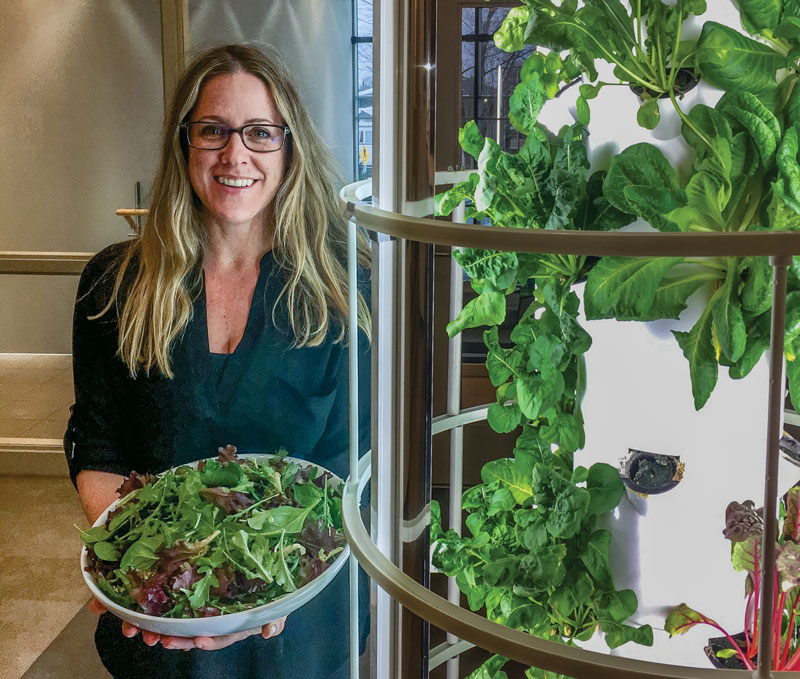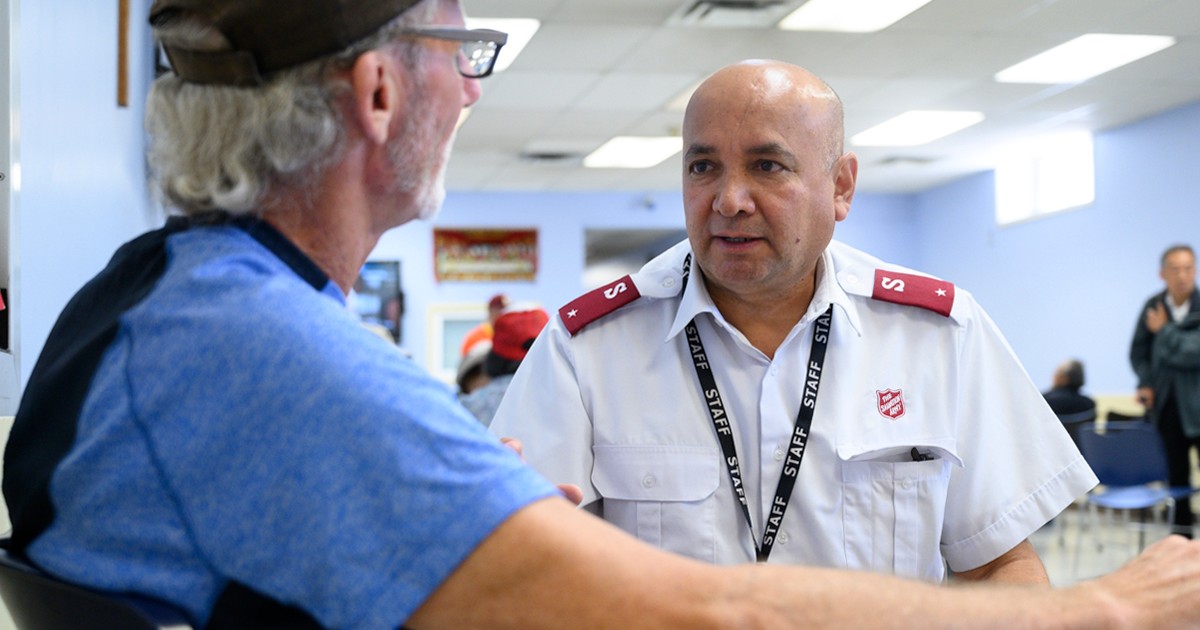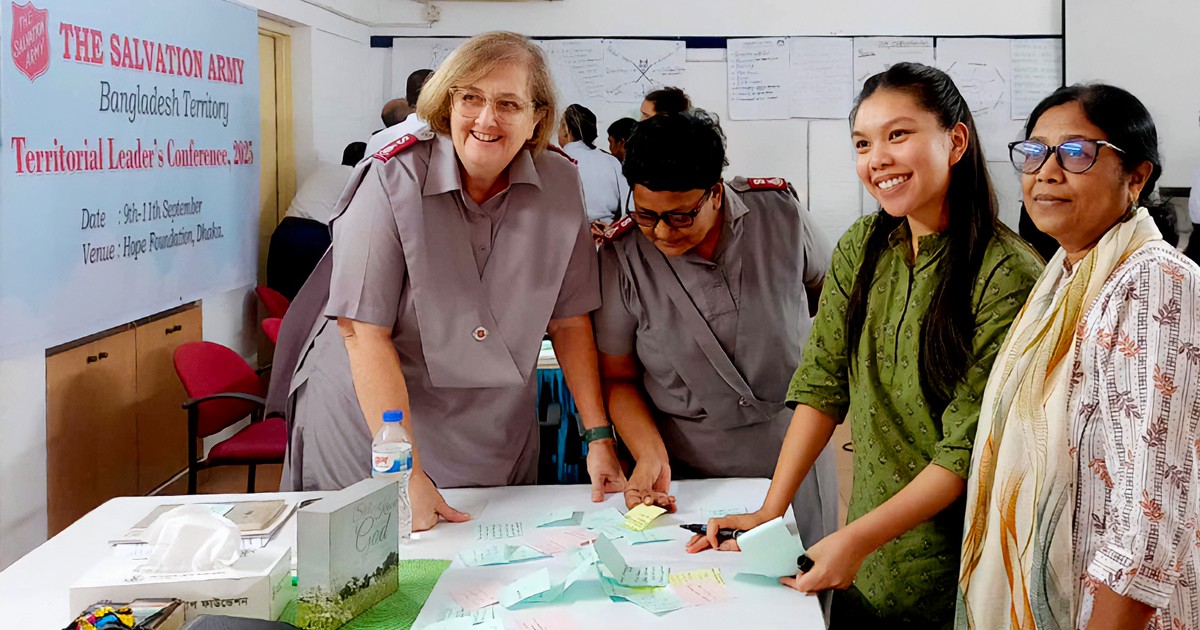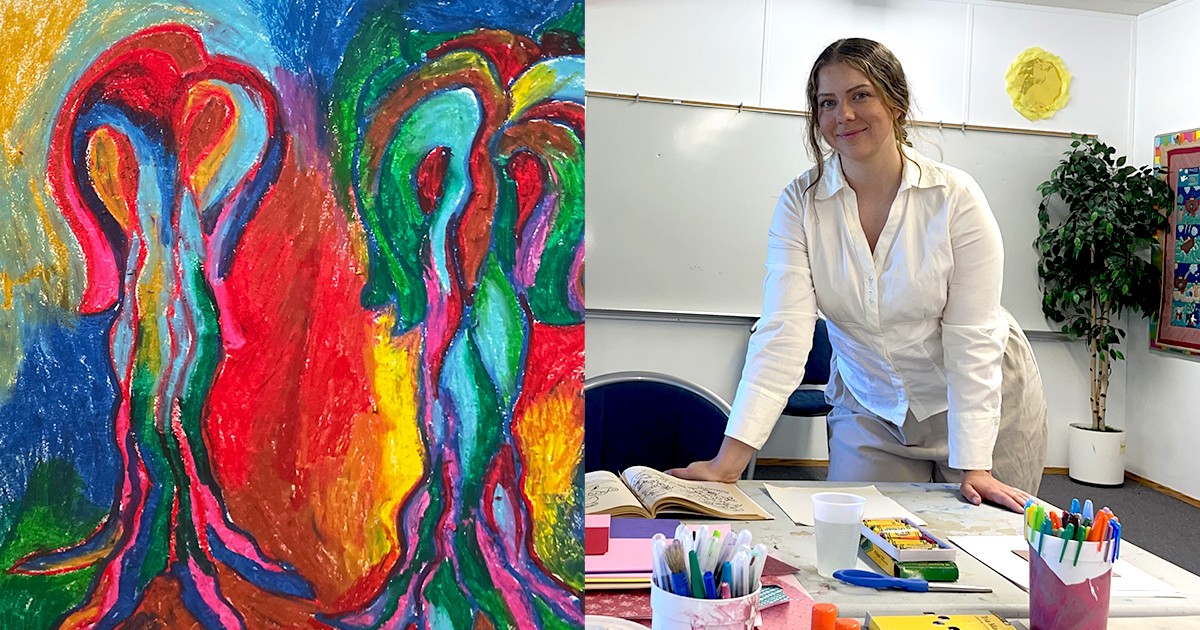When The Salvation Army Bethany Hope Centre in Ottawa serves lunch to the young parent families who participate in their programs during the week, salad is always on the menu—with fresh lettuce picked from the tower garden just down the hall. The futuristic-looking vertical garden, which uses aeroponics to grow plants without soil, is part of the Nourish Family Food Centre.
“Our young families need good food as a way to nourish their bodies and promote healthy child development,” says Dennise Yarema, Nourish Family Food Centre co-ordinator. “But we don’t want to offer food in a way that does more harm than good. We are committed to a fair and healthy food system, and having a tower garden is one small way we are working toward that commitment.”
The food centre is a recent initiative at Bethany Hope, developed in 2016 after receiving a Salvation Army Feed My Lambs grant. “This grant allowed us to shift from a traditional, charitable model of food service to a community-based model that focuses on food security,” says Yarema. “Our goals are to increase access to affordable, nutritious and—where possible—local food; increase skills and knowledge around food; and advocate for the right to good food for all people.”
The Nourish programs include nutritional assessment and support, a learning centre, an outdoor community garden, a breakfast and school lunch box program, a “make and take” meal, and a food bank. They added the indoor garden after learning about them from another agency, and realizing it could be used to provide healthy food throughout the year and as a teaching tool.
“In the winter months, our delivery from the Ottawa Food Bank often lacks fruits and vegetables, so now we can supplement it with greens from the tower garden,” says Yarema. “We harvest about 15 heads of lettuce every two weeks.”
They purchased the tower garden from a distributor called Juice Plus+, and it came with seeds, a kit to start seedlings using rockwool, and liquid nutrients. “All you need is electricity to power the lights and the pump, and a level area,” says Yarema. The tower uses a method of growing plants called aeroponics. A reservoir at the base holds water and the nutrient mixture. A pump pushes the solution to the top of the tower, where it cascades down over the exposed plant roots.
A standard tower garden is 1.57 metres tall, about one metre in diameter, and holds up to 20 plants. It can grow vegetables, herbs, fruit and flowers—almost anything except root crops, grapevines, bushes and trees.
“We tried tomatoes and peppers, but you have to do the pollination yourself, so it’s a bit more complicated,” says Yarema. “If we got another tower, maybe we’d experiment a little bit more with some other fruits and vegetables.”
As well as greens for their weekly meals and food bank, the garden has provided many learning opportunities. “Some of the kids here in our playroom helped us plant our first seedlings, and pop them in the tower,” says Yarema. “And we have a few participants who have taken responsibility for the upkeep—checking the water and nutrient levels two or three times a week—along with their kids.”
Although the maintenance is simple, it needs to be consistent. “If a ministry unit was closed for several weeks, you’d need someone to come in and check on it—just like your house plants,” says Yarema. “But the biggest surprise is that it was a lot easier than we thought it was going to be. It produces more food than we thought, faster than we thought.”
The garden tower has allowed the children and young parents at Bethany Hope Centre to explore growing food, and see where it comes from.
“Having gardens on-site, whether indoors or outdoors, allows our community to be part of their own food system,” says Yarema. “Instead of just giving our participants food from our food bank, we are able to invite them to be part of the entire process from start to end, seed to table.”
“Our young families need good food as a way to nourish their bodies and promote healthy child development,” says Dennise Yarema, Nourish Family Food Centre co-ordinator. “But we don’t want to offer food in a way that does more harm than good. We are committed to a fair and healthy food system, and having a tower garden is one small way we are working toward that commitment.”
The food centre is a recent initiative at Bethany Hope, developed in 2016 after receiving a Salvation Army Feed My Lambs grant. “This grant allowed us to shift from a traditional, charitable model of food service to a community-based model that focuses on food security,” says Yarema. “Our goals are to increase access to affordable, nutritious and—where possible—local food; increase skills and knowledge around food; and advocate for the right to good food for all people.”
The Nourish programs include nutritional assessment and support, a learning centre, an outdoor community garden, a breakfast and school lunch box program, a “make and take” meal, and a food bank. They added the indoor garden after learning about them from another agency, and realizing it could be used to provide healthy food throughout the year and as a teaching tool.
“In the winter months, our delivery from the Ottawa Food Bank often lacks fruits and vegetables, so now we can supplement it with greens from the tower garden,” says Yarema. “We harvest about 15 heads of lettuce every two weeks.”
They purchased the tower garden from a distributor called Juice Plus+, and it came with seeds, a kit to start seedlings using rockwool, and liquid nutrients. “All you need is electricity to power the lights and the pump, and a level area,” says Yarema. The tower uses a method of growing plants called aeroponics. A reservoir at the base holds water and the nutrient mixture. A pump pushes the solution to the top of the tower, where it cascades down over the exposed plant roots.
A standard tower garden is 1.57 metres tall, about one metre in diameter, and holds up to 20 plants. It can grow vegetables, herbs, fruit and flowers—almost anything except root crops, grapevines, bushes and trees.
“We tried tomatoes and peppers, but you have to do the pollination yourself, so it’s a bit more complicated,” says Yarema. “If we got another tower, maybe we’d experiment a little bit more with some other fruits and vegetables.”
As well as greens for their weekly meals and food bank, the garden has provided many learning opportunities. “Some of the kids here in our playroom helped us plant our first seedlings, and pop them in the tower,” says Yarema. “And we have a few participants who have taken responsibility for the upkeep—checking the water and nutrient levels two or three times a week—along with their kids.”
Although the maintenance is simple, it needs to be consistent. “If a ministry unit was closed for several weeks, you’d need someone to come in and check on it—just like your house plants,” says Yarema. “But the biggest surprise is that it was a lot easier than we thought it was going to be. It produces more food than we thought, faster than we thought.”
The garden tower has allowed the children and young parents at Bethany Hope Centre to explore growing food, and see where it comes from.
“Having gardens on-site, whether indoors or outdoors, allows our community to be part of their own food system,” says Yarema. “Instead of just giving our participants food from our food bank, we are able to invite them to be part of the entire process from start to end, seed to table.”










Leave a Comment